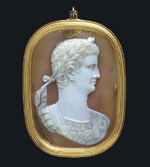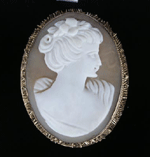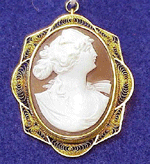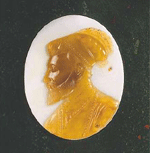When Was
-
The Cameo Invented?
By Mike McLeod
Cameos layered low relief carvings in stones or shell, often on a colored
background were first created in ancient Egypt possibly in the 6th century
B.C., but other countries and peoples soon fell in love with them. The Greeks,
Romans, Persians, French and English were all adept at cameo carving.
The
British royalty of the 18th, 19th, and 20th centuries have collected cameos,
including Queen Caroline (1683-1737, Consort to George II), Queen Mary
(1867-1953, Consort of George V, not Mary Queen of Scots), Queen Elizabeth
(1900-2002, the Queen Mother), George III (1738-1820) and Queen Victoria
(1819-1901). A few of the other famous cameo collectors throughout history
include: Julius Caesar, Napoleon, Catherine the Great and Pope Paul II. Both the
Vatican and Napoleon established schools or workshops for cameo carvers.
Among royalty, Queen Caroline created a noteworthy collection of cameos,
some dating from the 1500s. King George III, who was also famous for losing the
Revolutionary War to the colonists, acquired a grand collection of cameos that
put him among the top collectors in the world at that time. During his reign,
cameo collecting reached a pinnacle. Queen Victoria had a particular love for
the jasperware cameos of Josiah Wedgwood. Her love for cameos in general and her
regular wearing of them inspired the women of her day to follow her style, which
created a great demand for them and a thriving cameo industry.
The proper
Victorian woman wore cameos morning, noon and night. From England and Europe,
cameos made their way to America as treasured souvenirs and status symbols from
grand tours of the Continent taken by the social elite. In 1876, a large and
impressive collection of cameos was displayed at the Centennial Exhibition in
Philadelphia, which served to increase their popularity.
Over the years,
cameos have been carved out of gemstones, shell, coral, gutta percha, lava rock,
glass, celluloid and other manmade materials. The most common theme in cameo
carving was (and is) the profile of a woman, but cameos can also be found
featuring men, landscapes, animals, cherubs, deities, mythological scenes and
more.
While varying in value according to age, subject, quality and rarity,
cameos have sold for a few dollars and for hundreds of thousands of dollars. The
highest price paid to date for a cameo was $1,044,091. Sold by Bonhams UK in May
2003, this extraordinary cameo was a sardonyx portrait of the Mughal Emperor
Shah Jahan who reigned India from 1628 to 1658. Dated to circa 1630-40, it was
cut from brown layer stone on a white background.
Cameos have proven to be a
timeless collectible. They are as intensely loved today as they were in the days
of the Egyptians and Romans.
|

Onyx cameo of Emperor Claudius, 41-54 A.D., with a
laurel wreath in his wavy
hair;
3 in. long; $321,000.
(Photo: Invaluable.com)

Upswept hair is a clue to
dating a cameo as possibly Victorian of the 20th
century.
This shell cameo is dated to
ca. 1900. (Photo:
www.heritagejewellery.co.uk)

Profile of a Greco-Roman
woman in the Romanesque style (straight nose) that
may date to pre-1850; sold for $252.
(Photo: Invaluable.com)

The sardonyx portrait of Mughal Emperor Shah Jahan was estimated at
$64,400-$96,600 and returned $1.04 million, the highest ever paid for a cameo.
(Photo: Invaluable.com) |